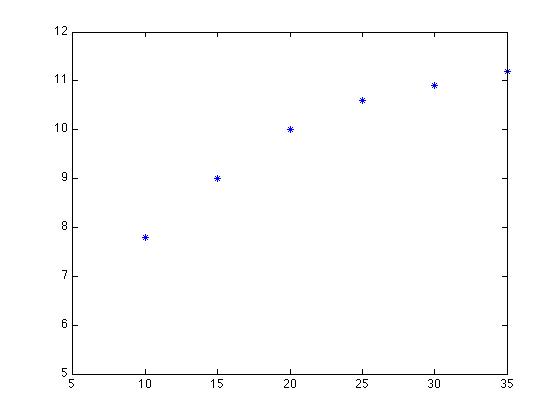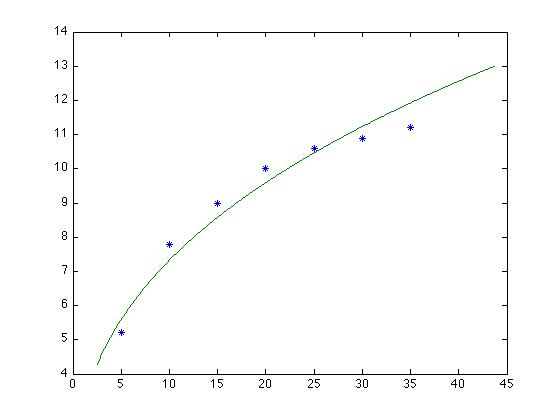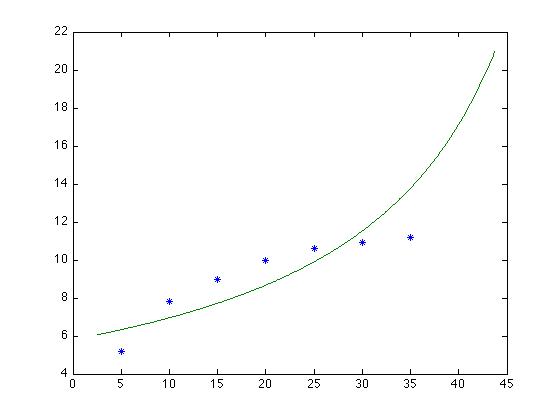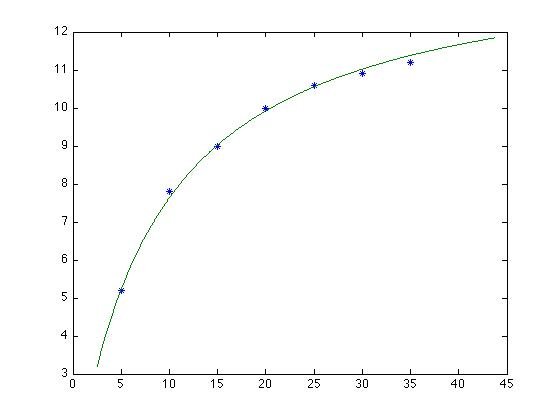function d = distance(v, theta) th = theta * pi/180; % Convert to radians d = (v^2 / 9.8) * sin(2*th); endThen we define a function target900(theta), that simply calls distance() with the givens of the problem (namely, 100 m/s initial velocity and 900 m distance), which evaluates to 0 at the solution:
function x = target900(theta) x = distance(100, theta) - 900; end(We could also implement everything in one function, but separating them is less error-prone and therefore better programming practice.)
Then we just call fzero() with this latter function and a guess:
>> fzero(@target900, 25)
ans =
30.9423
This is one answer; since the maximum distance occurs at 45 degrees,
there might be another; we try a different initial guess:
>> fzero(@target900, 75)
ans =
59.0577
>>
There are thus two solutions, about 31° and about 59°.
(Excel gives the same solutions.)
function Delta = prob1b(x) Delta = x.^5 - 200; endAnd then use fzero():
>> fzero(@prob1b,3)
ans =
2.8854
>>
So the fifth root of 200 is 2.8854.
function P = van_der_Waals(n,V,TC) T = TC + 273.15; % Convert temp to Kelvin R = 0.08206; % Gas constant (given) a = 1.39; % Materials constants for N b = 0.03919; P = (n*R*T) / (V-b) - (n^2 * a) / V^2; endAnd a second one that goes to zero as pressure goes to 13.5:
function y = prob1c(V) y = van_der_Waals(1.5, V, 25) - 13.5; endCalling fzero() yields:
>> fzero(@prob1c,12)
ans =
2.6722
Excel gives the same result.
>> x = A\b
>> 19.9939
29.9204
0.9773
0.0139
-2.9994
>>
>> load A.txt
>> load b.txt
>> x = A\b
x =
1.0000
2.0000
3.0000
4.0000
5.0000
6.0000
7.0000
8.0000
9.0000
10.0000
>>
Now, if we fit a line to the given R-vs.-T data
(using polyfit()), we will get the two
coefficients, m and
and b. We can then calculate:
m = R0 α
b = R0(1 – 20α)
Rearranging, we get:
R0 = m/α
α = m/(b+20m))
So:
>> T = [20 100 180 260 340 420 500]; % Observed temperatures
>> R = [500 676 870 1060 1205 1410 1565]; % Observed resistance
>> c = polyfit(T, R, 1) % Caculate best linear fit
c =
2.2312 460.7321
>> plot(T,R, '*', T, polyval(c,T))
Now, with m=c(1) and b=c(2), we can
compute R0 and α:
>> alpha = c(1)/(c(2) + 20*c(1)); >> R0 = c(1)/alpha; >> plot(T,R,'*',T,R0*(1+alpha*(T-20))); >>And the plot confirms an excellent fit with the data. Just to be sure, we do a goodness-of-fit test, by fitting a line to the measured and predicted R values:
>> RR = R0*(1+alpha*(T-20));
>> polyfit(R,RR,1)
ans =
0.9989 1.1629
>>
This is a very good fit.
load dat.txt; u = dat(:,1); V = dat(:,2);Now, if u = AeBV, we can take the log of both sides and get ln(u) = ln(A) + BV — according to the pattern in the second row of the table in the assignment. This is of the form y = mx + b, but with ln(u) instead of y, B instead of m, and ln(A) instead of b. We need to transform the data so we can solve for m and b with polyfit(); we have to give it ln(u) instead of u:
F = polyfit(V, log(u), 1)
F =
6.5133 -45.1425
>>
Now we know the value of m and b. Now B = m, but
to get A we have to exponentiate b:
>> B = F(1); >> A = exp(F(2));Now we can plot the function and data:
>> plot(V,u,'*',V,A*exp(B*u));The plot looks funny because the values of the independent variable are not sorted in increasing order. We can sort the original matrix (use sortrows(dat,2) to sort on the second column) and plot again, or just do a goodness-of-fit test:
>> polyfit(u,A*exp(B*V),1)
ans =
1.0388 -1.2599
This confirms a pretty good fit. (Note that the regression methods do
not depend on the data being sorted in any way; the data is simply
considered as a set of pairs. For plotting, however, it is useful to
have the data sorted on the independent variable.)
>> Age = [5:5:35]; % from 5 to 35 by 5's >> Height = [5.2 7.8 9 10 10.6 10.9 11.2]; >> plot(Age, Height, '*') % Graph shows that the relation is nonlinearThis gives:

>> F = polyfit(log(Age), log(Height), 1)
F =
0.3888 1.0961
>> m1 = F(1)
m1 =
0.3888
>> b1 = exp(F(2))
b1 =
2.9924
We plot it, using a more finer-grained x-axis to get a better fit:
>> Age_range = [min(Age)/2:0.05:max(Age)*1.25]; >> H1 = b1 * Age_range .^ m1; >> plot(Age, Height, '*', Age_range, H1)This gives:

>> polyfit(Height,b1*Age.^m1,1)
ans =
1.0239 -0.2199
Exponential curves never have this shape, so we need not bother with
that form. Although it seems unlikely that the third form will fit
either, we give it a try:
y = 1/(mx + b) or
1/y = mx + b. Again, we transform the data by taking the
reciprocal before giving it to polyfit():
>> F = polyfit(Age, 1./Height, 1) F = -0.0028 0.1723 >> m2 = F(1); >> b2 = F(2); >> H2 = 1./(m2 * Age_range + b2); >> plot(Age, Height, '*', Age_range, H2)This gives:

Finally, we try the form y = (mx)/(x+b), which transforms into 1/y = b/mx + 1/m. For this we have to give the reciprocal of both Age and Height to polyfit(); we get back as coefficients (i.e., F(1) and F(2)) b/m and 1/m, respectively. This means that m = 1/F(2) and b = m*F(1).
>> F = polyfit(1./Age,1./Height,1)
F =
0.6025 0.0706
>> m3 = 1/F(2)
m3 =
14.1546
>> b3 = m3*F(1)
b3 =
8.5285
>> H3 = (m3 * Age_range) ./ (Age_range + b3);
>> plot(Age,Height,'*',Age_range,H3)
The plot looks like this:
>> polyfit(Height,(m3*Age)./(Age + b3),1)
ans =
1.0195 -0.1692
>>
This is the best fit yet, and so we conclude that tree height varies
with age according to: